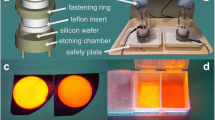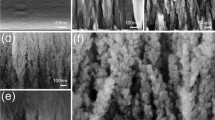Abstract
We present a method that employs the metal-assisted chemical etching technique and a subsequent NH3 plasma treatment for obtaining silica nanoparticles (SNPs) uniformly distributed on an amorphous silicon-rich silicon nitride (SRN) film. These particles ranging from 50 to 300 nm are formed directly from the SRN films, and their density is related to the flow rate of the precursor gas (SiCl4). We determined that the SNPs are a SiOx compound (x > 1) with amorphous structure. Furthermore, the chemical composition of the bulk of the remaining SRN film after the etching in a HF/H2O2-based solution and plasma treatment maintain the properties of a pristine one if the initial thickness of the film is large enough (≥ 1 µm). This method enables the formation of silica nanoparticles directly on a silicon-rich silicon nitride film that could have potential optoelectronic applications, implicit in the optical measurements.






Similar content being viewed by others
References
Björk MT, Hayden O, Schmid H et al (2007) Vertical surround-gated silicon nanowire impact ionization field-effect transistors. Appl Phys Lett 90:142110. https://doi.org/10.1063/1.2720640
Schmidt V, Riel H, Senz S et al (2006) Realization of a silicon nanowire vertical surround-gate field-effect transistor. Small 2:85–88. https://doi.org/10.1002/smll.200500181
Cabañas-Tay SA, Palacios-Huerta L, Aceves-Mijares M et al (2017) Influence of the gate and dielectric thickness on the electro-optical performance of SRO-based LECs: resistive switching, IR and deep UV emission. J Lumin 192:919–924. https://doi.org/10.1016/j.jlumin.2017.08.034
Svrcek V, Yamanari T, Mariotti D et al (2015) A silicon nanocrystal/polymer nanocomposite as a down-conversion layer in organic and hybrid solar cells. Nanoscale 7:11566–11574. https://doi.org/10.1039/C5NR02703A
Lou J, Tong L, Ye Z (2005) Modeling of silica nanowires for optical sensing. Opt Express 13:2135–2140. https://doi.org/10.1364/OPEX.13.002135
Luque A, Martí A, Nozik AJ (2007) Solar cells based on quantum dots: multiple exciton generation and intermediate bands. MRS Bull 32:236–241. https://doi.org/10.1557/mrs2007.28
Tian B, Zheng X, Kempa TJ et al (2007) Coaxial silicon nanowires as solar cells and nanoelectronic power sources. Nature 449:885–889. https://doi.org/10.1038/nature06181
Fang H, Li X, Song S et al (2008) Fabrication of slantingly-aligned silicon nanowire arrays for solar cell applications. Nanotechnology 19:255703. https://doi.org/10.1088/0957-4484/19/25/255703
Bhunia SK, Nandi S, Shikler R, Jelinek R (2016) Tuneable light-emitting carbon-dot/polymer flexible films prepared through one-pot synthesis. Nanoscale 8:3400–3406. https://doi.org/10.1039/C5NR08400H
Kherani NP (2015) Nano architectures in silicon photovoltaics. Springer, Singapore, pp 37–62
Liu H, Huang Z, Huang J et al (2016) Morphology controlling method for amorphous silica nanoparticles and jellyfish-like nanowires and their luminescence properties. Sci Rep 6:22459. https://doi.org/10.1038/srep22459
Du C, Wei T, Zheng H et al (2013) Size-controllable nanopyramids photonic crystal selectively grown on p-GaN for enhanced light-extraction of light-emitting diodes. Opt Express 21:25373–25380. https://doi.org/10.1364/OE.21.025373
Chan CK, Peng H, Liu G et al (2008) High-performance lithium battery anodes using silicon nanowires. Nat Nanotechnol 3:31–35. https://doi.org/10.1038/nnano.2007.411
Fojtik A, Weller H, Fiechter S, Henglein A (1987) Preparation of colloidal silicon and preliminary photochemical experiments. Chem Phys Lett 134:477–479. https://doi.org/10.1016/0009-2614(87)87176-2
Bitar A, Ahmad NM, Fessi H, Elaissari A (2012) Silica-based nanoparticles for biomedical applications. Drug Discov Today 17:1147–1154. https://doi.org/10.1016/j.drudis.2012.06.014
Behray M, Webster CA, Pereira S et al (2016) Synthesis of diagnostic silicon nanoparticles for targeted delivery of thiourea to epidermal growth factor receptor-expressing cancer cells. ACS Appl Mater Interfaces 8:8908–8917. https://doi.org/10.1021/acsami.5b12283
Azioune A, Ben Slimane A, Ait Hamou L et al (2004) Synthesis and characterization of active ester-functionalized polypyrrole − silica nanoparticles: application to the covalent attachment of proteins. Langmuir 20:3350–3356. https://doi.org/10.1021/la030407s
Bochkova OD, Mustafina AR, Fedorenko SV, Konovalov AI (2011) Silica nanoparticles with a substrate switchable luminescence. J Phys: Conf Ser 291:012038. https://doi.org/10.1088/1742-6596/291/1/012038
Santra S, Bagwe RP, Dutta D et al (2005) Synthesis and characterization of fluorescent, radio-opaque, and paramagnetic silica nanoparticles for multimodal bioimaging applications. Adv Mater 17:2165–2169. https://doi.org/10.1002/adma.200500018
Santra S, Yang H, Dutta D et al (2004) TAT conjugated, FITC doped silica nanoparticles for bioimaging applications. Chem Commun. https://doi.org/10.1039/b411916a
Vaccaro L, Morana A, Radzig V, Cannas M (2011) Bright visible luminescence in silica nanoparticles. J Phys Chem C 115:19476–19481. https://doi.org/10.1021/jp204350u
Liyana VP, Aminakutty N, Shiju K, Predeep P (2014) Organic field effect transistor with silica nanoparticles on gate dielectric. Asian J Appl Sci 7:696–704. https://doi.org/10.3923/ajaps.2014.696.704
Stöber W, Fink A, Bohn E (1968) Controlled growth of monodisperse silica spheres in the micron size range. J Colloid Interface Sci 26:62–69. https://doi.org/10.1016/0021-9797(68)90272-5
Nandy S, Kundu D, Naskar MK (2014) Synthesis of mesoporous Stöber silica nanoparticles: the effect of secondary and tertiary alkanolamines. J Sol-Gel Sci Technol 72:49–55. https://doi.org/10.1007/s10971-014-3420-7
Han Y, Lu Z, Teng Z et al (2017) Unraveling the growth mechanism of silica particles in the Stöber method: in situ seeded growth model. Langmuir 33:5879–5890. https://doi.org/10.1021/acs.langmuir.7b01140
Aubert T, Grasset F, Mornet S et al (2010) Functional silica nanoparticles synthesized by water-in-oil microemulsion processes. J Colloid Interface Sci 341:201–208. https://doi.org/10.1016/j.jcis.2009.09.064
Abdali A, Moritz B, Wiggers H, Schulz C (2010) Gas-phase synthesis of silica nanoparticles in a hybrid microwave plasma hot-wall reactor. TechConnect Briefs 1:334–337
Mostajeran Goortani B, Mendoza N, Proulx P (2006) Synthesis of SiO2 nanoparticles in RF plasma reactors: effect of feed rate and Quench gas injection. Int J Chem React Eng. https://doi.org/10.2202/1542-6580.1330
Huang Z, Geyer N, Werner P et al (2011) Metal-assisted chemical etching of silicon: a review. Adv Mater 23:285–308. https://doi.org/10.1002/adma.201001784
Han H, Huang Z, Lee W (2014) Metal-assisted chemical etching of silicon and nanotechnology applications. Nano Today 9:271–304. https://doi.org/10.1016/j.nantod.2014.04.013
Muldera J, Cabello NI, Ragasa JC et al (2013) Photocarrier transport and carrier recombination efficiency in vertically aligned Si nanowire arrays synthesized via metal-assisted chemical etching. Appl Phys Express 6:082101. https://doi.org/10.7567/APEX.6.082101
Holländer B, Buca D, Mantl S, Hartmann JM (2010) Wet chemical etching of Si, Si1−xGex, and Ge in HF:H2O2:CH3COOH. J Electrochem Soc 157:H643–H646. https://doi.org/10.1149/1.3382944
Osminkina LA, Gonchar KA, Marshov VS et al (2012) Optical properties of silicon nanowire arrays formed by metal-assisted chemical etching: evidences for light localization effect. Nanoscale Res Lett 7:524. https://doi.org/10.1186/1556-276X-7-524
Cruz S, Hönig-d’Orville A, Müller J (2005) Fabrication and optimization of porous silicon substrates for diffusion membrane applications. J Electrochem Soc 152:C418–C424. https://doi.org/10.1149/1.1914747
Huang Z, Shimizu T, Senz S et al (2009) Ordered arrays of vertically aligned [110] silicon nanowires by suppressing the crystallographically preferred < 100 > etching directions. Nano Lett 9:2519–2525. https://doi.org/10.1021/nl803558n
Vinzons LU, Shu L, Yip S et al (2017) Unraveling the morphological evolution and etching kinetics of porous silicon nanowires during metal-assisted chemical etching. Nanoscale Res Lett 12:385. https://doi.org/10.1186/s11671-017-2156-z
Li X, Bohn PW (2000) Metal-assisted chemical etching in HF/H2O2 produces porous silicon. Appl Phys Lett 77:2572–2574. https://doi.org/10.1063/1.1319191
Liu G, Young KL, Liao X et al (2013) Anisotropic nanoparticles as shape-directing catalysts for the chemical etching of silicon. J Am Chem Soc 135:12196–12199. https://doi.org/10.1021/ja4061867
Harada Y, Li X, Bohn PW, Nuzzo RG (2001) Catalytic amplification of the soft lithographic patterning of Si. Nonelectrochemical orthogonal fabrication of photoluminescent porous Si pixel arrays. J Am Chem Soc 123:8709–8717. https://doi.org/10.1021/ja010367j
Lova P, Robbiano V, Cacialli F et al (2018) Black GaAs by metal-assisted chemical etching. ACS Appl Mater Interfaces 10:33434–33440. https://doi.org/10.1021/acsami.8b10370
Douani R, Piret G, Hadjersi T et al (2011) Formation of a-Si: H and a-Si1−xCx: H nanowires by Ag-assisted electroless etching in aqueous HF/AgNO3 solution. Thin Solid Films 519:5383–5387. https://doi.org/10.1016/j.tsf.2011.02.047
Muñoz-Rosas A, Rodríguez-Gómez A, Alonso-Huitrón J (2018) Enhanced electroluminescence from silicon quantum dots embedded in silicon nitride thin films coupled with gold nanoparticles in light emitting devices. Nanomaterials 8:182. https://doi.org/10.3390/nano8040182
Serrano-Núñez MA, Rodríguez-Gómez A, Escobar-Alarcón L, Alonso-Huitrón JC (2016) Combined study of the effect of deposition temperature and post-deposition annealing on the photoluminescence of silicon quantum dots embedded in chlorinated silicon nitride thin films. RSC Adv 6:77440–77451. https://doi.org/10.1039/C6RA15723H
Santana G, Monroy BM, Ortiz A et al (2006) Influence of the surrounding host in obtaining tunable and strong visible photoluminescence from silicon nanoparticles. Appl Phys Lett 88:041916. https://doi.org/10.1063/1.2164919
Hegde RI, Tobin PJ, Reid KG et al (1995) Growth and surface chemistry of oxynitride gate dielectric using nitric oxide. Appl Phys Lett 66:2882–2884. https://doi.org/10.1063/1.113461
Kärcher R, Ley L, Johnson RL (1984) Electronic structure of hydrogenated and unhydrogenated amorphous SiNx photoemission study. Phys Rev B 30:1896–1910. https://doi.org/10.1103/PhysRevB.30.1896
Gupta M, Rathi VK, Thangaraj R et al (1991) The preparation, properties and applications of silicon nitride thin films deposited by plasma-enhanced chemical vapor deposition. Thin Solid Films 204:77–106. https://doi.org/10.1016/0040-6090(91)90495-J
Aiyama T, Fukunaga T, Niihara K et al (1979) An X-ray diffraction study of the amorphous structure of chemically vapor-deposited silicon nitride. J Non Cryst Solids 33:131–139. https://doi.org/10.1016/0022-3093(79)90043-7
Umesaki N, Hirosaki N, Hirao K (1992) Structural characterization of amorphous silicon nitride by molecular dynamics simulation. J Non Cryst Solids 150:120–125. https://doi.org/10.1016/0022-3093(92)90107-U
Gritsenko VA (2012) Electronic structure of silicon nitride. Phys Usp 55:498–507. https://doi.org/10.3367/UFNe.0182.201205d.0531
Gritsenko V, Xu J, Kwok R et al (1998) Short range order and the nature of defects and traps in amorphous silicon oxynitride governed by the Mott rule. Phys Rev Lett 81:1054–1057. https://doi.org/10.1103/PhysRevLett.81.1054
Jiang X, Ma Z, Xu J et al (2015) a-SiNx:H-based ultra-low power resistive random access memory with tunable Si dangling bond conduction paths. Sci Rep 5:15762. https://doi.org/10.1038/srep15762
Brunet M, Aureau D, Chantraine P et al (2017) Etching and chemical control of the silicon nitride surface. ACS Appl Mater Interfaces 9:3075–3084. https://doi.org/10.1021/acsami.6b12880
Liu L-H, Michalak DJ, Chopra TP et al (2016) Surface etching, chemical modification and characterization of silicon nitride and silicon oxide—selective functionalization of Si3N4 and SiO2. J Phys: Condens Matter 28:094014. https://doi.org/10.1088/0953-8984/28/9/094014
Kim D, Kim D, Kim H et al (2011) Effect of ammonia (NH3) plasma treatment on silicon nitride (SiNx) gate dielectric for organic thin film transistor with soluble organic semiconductor. Curr Appl Phys 11:S67–S72. https://doi.org/10.1016/j.cap.2011.05.021
Acknowledgements
All authors would like to acknowledge the support provided by Lázaro Huerta Arcos and M. A. Canseco in the use and interpretation of XPS and FTIR techniques, respectively. The authors are also grateful to Fis. Roberto Hernández and Dr. Samuel Tehuacanero Cuapa for technical assistance in the TEM analysis as well as to Dr. Carlos G. Treviño Palacios for the instrumentation support for I–V measurements. The first author is grateful to the Dirección General de Asuntos del Personal Académico (DGAPA-UNAM) for the granted Postdoctoral Fellowship. This research work was financially supported by projects: (a) Investigación Científica Básica SEP—CONACYT Project Nos.: 283492 and 253754, Conacyt Fronteras 344 (b) PAPIIT-UNAM, Project Nos.: IG100519 (c) CONACyT 253754 and (d) PAPIIT-UNAM, Project Nos.: IA102718 and IN106316.
Author information
Authors and Affiliations
Corresponding author
Additional information
Publisher's Note
Springer Nature remains neutral with regard to jurisdictional claims in published maps and institutional affiliations.
Electronic supplementary material
Below is the link to the electronic supplementary material.
Rights and permissions
About this article
Cite this article
Muñoz-Rosas, A.L., Rodríguez-Gómez, A., Alonso-Huitrón, J.C. et al. The use of MACE technique on amorphous silicon-rich silicon nitride thin films for the formation of spherical silica nanoparticles. J Mater Sci 54, 14296–14308 (2019). https://doi.org/10.1007/s10853-019-03937-3
Received:
Accepted:
Published:
Issue Date:
DOI: https://doi.org/10.1007/s10853-019-03937-3




